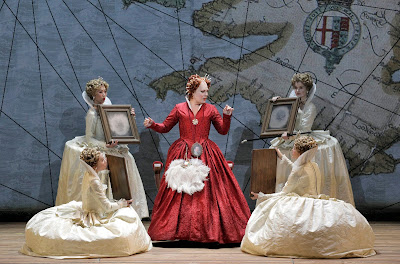It felt humbling to hear “The Star-Spangled Banner” sung aloud by a full house with orchestra for the opening of Los Angeles Opera’s 2018-19 season, making the immensity of the Dorothy Chandler Pavilion feel like a small community hall. Then, Music Director and conductor James Conlon launched into what was to be a searing revival of Ian Judge’s 2006 production of Verdi’s Don Carlo - an epic work characterised by political and religious oppression, of suspicion, punishment and seeds of rebellion.
 |
| Scene from Act 2 of LA Opera's Don Carlo |
When Plácido Domingo took the stage as Rodrigo on opening night, he looked a striking figure of a man half his almost 78 years of age. If he had underperformed, his adoring local audience would still likely offer adulation in truckloads but Domingo’s was a highly nuanced and commanding performance. It’s simply difficult not to remain aghast before this living legend of opera whose mystique infiltrates the stage. Domingo's former tenor voice may not burn with deep and vivid Verdian baritone colours but his intoxicating vocal engine ran smoothly, phrasing came with utter conviction and his strong acting skills showed a man who understands situational subtleties. Domingo’s final act aria, which he sings to the imprisoned Carlo - a warm and passionate tenor in Ramón Vargas - made a particularly poignant moment. With Vargas, a generous and unified military stride accompanied their duets.
 |
| Plácido Domingo as Rodrigo |
The luxury casting of Italian bass Ferruccio Furlanetto as Philip II paid off with impressive results (Alexander Vinogradov takes over from 4th October). One of the production’s many highlights arrived immediately after interval, opening the first scene of Act 3, at dawn in the King’s study. Angled over his desk, Furlanetto’s was the most compelling performance I’ve seen of the role as he sang despairingly of the king's awareness that Elizabeth never loved him. But what followed will remain unforgettable. To have two deliciously contrasting bass singers together, Furlanetto as Philip II and Morris Robinson as the the blind Grand Inquisitor, was like having gravel and granite mixed and sculptured in divine proportion by God himself. In their duet, entwined with the formidable groaning bass in the pit, Church and State’s uneasy co-existence became dramatically illuminated by these two phenomenal figures.
 |
| Morris Robinson and Ferruccion Furlanetto |
Through to the bottom of the cast list, a strong display of vocal talent came from members of the Domingo-Colburn-Stein Young Artist Program with Taylor Raven as Tebaldo, Joshua Wheeker as Count Lerma and Liv Redpath as the Celestial Voice. Further gifting the ear, a resonating swell of voices combined magnificently under Chorus Director Grant Gershon’s command, giving the processional Auto-da-fé scene tremendous grandeur - and it looked a menacing reminder as Christ on the Cross looked down in judgement - even though the scene’s realisation looked static.
 |
| Ramón Vargas as Carlo and Ana María Martínez as Elizabeth |
In the pit, with the LA Opera orchestra sounding so wonderfully primed, conductor James Conlon demonstrated an eagerness to provide pronounced contrasts between the majestically thunderous and delicately threaded parts of the score, though often punctuating it at the expense of overall cohesive flow. Nonetheless, after a rather tepid first act, the dramatic heft was never in doubt and the singer’s were supported gloriously.
In all but it’s puzzling ghost of Carlo V ending - and it fell noticeably flat on an audience seemingly unsure if it was over - Don Carlos looked and sounded the masterpiece it can be. A little more directorial vigour, however, would help to light it up superbly.
Don Carlos
Los Angeles Opera
Dorothy Chandler Pavilion, LA Music Centre
Until 14th October, 2018.
Production Photos: Cory Weaver







